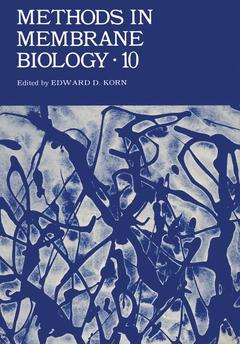Methods in Membrane Biology, Softcover reprint of the original 1st ed. 1979 Volume 10
Langue : Anglais
Auteur : Korn Edward D.

Three articles make up Volume 10 of Methods in Membrane Biology. In the first of these, Papahadjopoulos, Poste, and Vail extensively review much of the available data on the fusion of natural membranes, model membranes (liposomes), and natural membranes with liposomes. The authors are led by their review of the experimental methods and their interpretations of the results obtained to a general theory of membrane fusion which they believe is applicable to all systems that have been studied. Arguing that although protein and carbohydrate may serve, in some cases, to bring membranes into sufficiently close proximity for fusion to occur and, in other cases, to remove peripheral and integral proteins from the regions that are to undergo fusion, the authors conclude that membrane fusion per se is solely a property of the lipid bilayer. In their view, all the experimental observations to date can be subsumed under a unifying hypothesis in which membrane fusion is the result of a phase separation in one-half of the membrane bilayer brought about by the interaction - of calcium ions with acidic phospholipids, mostly phosphatidylserine. Where half-membranes already contain sufficient acidic phospholipids, a local increase in calcium ion concentration may suffice to induce fusion (examples might include exocytosis and fusion of intracellular membrane systems). In other cases, natural or experimentally induced events preceding fusion might be necessary to increase the local concentration of the acidic phospholipids in the half-membrane (virus-or fusogenic agent-induced cell-to-cell fusion, or endocytosis, for example).
1 Studies on Membrane Fusion with Natural and Model Membranes.- 1. Introduction.- 2. Spontaneous Cell Fusion.- 2.1. Fertilization.- 2.2. Myoblast Fusion.- 2.3. Fusion of Macrophages.- 2.4. Other Examples of Spontaneous Cell Fusion.- 3. Virus-Induced Cell Fusion.- 3.1. Two Kinds of Virus-Induced Cell Fusion.- 3.2. Cell Fusion by Inactivated Viruses: Techniques.- 3.3. Optimum Conditions for Virus-Induced Cell Fusion.- 3.4. Identification of the Viral Components Associated with Induction of Membrane Fusion.- 3.5. Virus-Cell Interactions in Virus-Induced Cell Fusion.- 3.6. Mechanisms.- 4. Chemically Induced Cell Fusion.- 5. Fusion of Subcellular Membranes.- 6. Interactions and Fusion of Lipid Vesicles with Cultured Cells.- 7. Fusion of Model Lipid Membranes (Vesicles and Black Lipid.- Films).- 7.1. Definitions, Systems of Study, Relative Advantages.- 7.2. Methods for Studying Fusion in Model Membranes.- 7.3. Fusion and Molecular Exchange with Pure Phospholipid Vesicles and Bilayers.- 7.4. Effects of Lysolecithin, Fatty Acids, DMSO, etc.- 7.5. Effects of Proteins and Polypeptides.- 7.6. Effects of Bivalent Metals (Calcium and Magnesium).- 7.7. Role of Phase Transitions and Phase Separations.- 8. Similarities between Different Forms of Membrane Fusion: A Possible Unifying Mechanism.- 8.1. Fusion Initiated at the Outer Face of Plasma Membranes.- 8.2. Fusion Initiated at the Inner (Cytoplasmic) Face of the Plasma Membrane and Fusion of Intracellular Organelles.- 9. References.- 2 Methods for Studying Transmission through Permeable Cell-to-Cell Junctions.- 1. Introduction.- 2. Measurements of Electrical Coupling.- 3. Measurements of Junctional Conductance.- 3.1. Single Junction.- 3.2. General Linear Array.- 3.3. Thin Sheet of Cells.- 4. Tracer Permeation Studies.- 4.1. Fluorescent Tracers.- 4.2. Loading the Tracer.- 4.3. Design and Analysis of Quantitative Studies.- 4.4. Autoradiography, with Injected Tracers.- 4.5. Electronopaque Tracers: Cobalt.- 5. Metabolic Cooperation.- 6. Controlling for Misleading Observations.- 6.1. Electrical Coupling Not Mediated by Junctions.- 6.2. Tracer Transfers Not Mediated by Membrane Junctions.- 6.3. Artifactual Closure of Channels.- 7. Comparative Utility of Various Approaches to the Quantitative Characterization of Junctional Transmittance.- 8. Appendixes.- 8.1. Appendix A: A Discrete Resistance Model of a Coupled Cell Chain with Intracellular Electrodes.- 8.2. Appendix B: Purifying and Dissolving 6-Carboxyfluorescein.- 9. References.- 3 An Approach to the Study of Electron Transport Systems.- 1. General Considerations in the Evaluation of Metabolic Pathways and Their Regulation.- 2. Some Concepts for Experimental Design and Interpretation.- 2.1. Principle of Detailed Balancing.- 2.2. On the Relationship between Thermodynamics and Kinetics.- 3. Thermodynamics and Oxidation-Reduction Reactions.- 3.1. Ligand Binding in Oxidation-Reduction Reactions.- 3.2. Behavior of Interacting Oxidation-Reduction Systems.- 4. Potentiometric Analysis: Some Technical Considerations.- 4.1. Role of Redox Mediators.- 4.2. Maintaining Anaerobic Conditions.- 4.3. Titrations in a Two-Phase System.- 4.4. Freeze-Trapped Samples.- 4.5. Application of Potentiometric Methods to Kinetic Analysis: Poise-Pulse Analysis.- 4.6. Automated Titration Methods: Redox Stats and Stoichiometric Titrations.- 5. Mitochondrial Oxidative Phosphorylation.- 5.1. Oxidation-Reduction Components and Their Thermodynamic Relationships.- 5.2. Coupling of the Oxidation-Reduction Reactions to ATP Synthesis.- 5.3. Identification of the Respiratory Control Site(s) and Its Characterization.- 6. Energy Transduction Reactions: Identification of Energy-Transducing Components.- 6.1. General Properties of Energy Transducers.- 6.2. Analysis by Internal Equilibration.- 6.3. Potentiometric Analysis.- 7. Conclusion.- 8. Appendix.- 9. References.
Date de parution : 12-2012
Ouvrage de 227 p.
15.2x22.9 cm
Disponible chez l'éditeur (délai d'approvisionnement : 15 jours).
Prix indicatif 52,74 €
Ajouter au panier
© 2024 LAVOISIER S.A.S.



